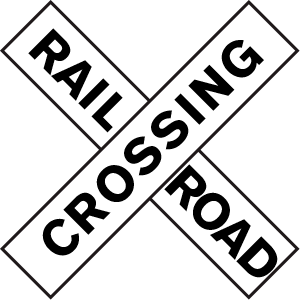Rail Crossing Warning Systems
The Stalwart Safety Sentinels of the Road
Uniquely American, they are common, highly sought after, and work through seemingly mysterious, but time-tested science. They are highway-rail grade crossing warning systems.
How they originated is an interesting story.
The basic technology goes back to 1870 when the track circuit was invented. The idea of using electric current in railroad rails for signaling was an idea that had been suggested as early as 1848. By dividing the railroad into "blocks" or sections, a circuit was devised to signal trains when a specific section of track was clear or occupied with other trains.
As America became laced with more railroads in the latter half of the 19th century, it became apparent that warning also should be given to people who wanted to cross the tracks. Initially, a colorful variety of signs were posted at crossings, depending on the whims of the local railroads, and in time, watchmen were stationed at the busier crossings to warn of approaching trains. Some of the crossings were equipped with gates that the watchmen manually cranked to lower or to raise.
As it wasn't practical to have people stationed at all the crossings, a way was sought to automatically alert the public that a train was approaching.
The Stalwart Safety Sentinels of the Road

By the 20th century, the use of "cross-buck" signs – the boards forming an "x" – were common. The design formed the basic sign still in use today.
The first automatic crossing signals were bells mounted atop poles. They were activated when a train entered a circuit where the rails were insulated to confine the electric current to a designated piece of track. The current flowed through the steel wheels and axles of the train, cutting off (short-circuiting) electricity to an electrical relay which needed the power to hold the electrical connection apart that kept the bell off. When the electricity was diverted through the train – which was a path of lower resistance – instead of the relay connection, the contacts connected and the bell rang.
The electric bell idea quickly was expanded to include a swinging round sign with a red light hanging from an arm on the signal pole to simulate a flagman waving a red lantern. Such "automatic flagmen" signals were soon dubbed "wig wags." A few wig wags remain in use today in the United States, much beloved by railfans for their nostalgic warning.
The wig wags gave way to the alternating flashing red lights mounted as part of a cross-buck sign, often used with gates as well. The first flashing red light signal was installed in New Jersey in 1913.
Today the basic designs come in a wide variety of configurations, depending on the complexity of the street crossing and the railroad. Each one is custom designed to fit a specific need.
Most crossing gates are designed to warn against motor traffic in the oncoming lanes, covering half the street, allowing an escape from the tracks for motorists who happen to be on the crossing when the signal is activated. At some crossings, a "cantilever" extends out above the street with additional flashing lights to warn motorists in multi-lane situations.
Many modern crossing signals have "constant warning" technology which not only allows for the warning time, but adjusts to the speed of the oncoming train to give the same amount of warning, regardless of whether or not the train is moving slowly or very rapidly. The goal is to give adequate warning, but not too much time that would encourage motorists to disregard the signal.
The Federal Railroad Administration minimum warning time is 20 seconds. Many states issue orders specifying the designed warning time at each crossing. Designed warning times vary from the low 20s to the high 30s, depending on the circumstances at the crossing.
In addition to the signals and signs, Federal rules require train crews to begin sounding the horn at least 15 seconds before entering the crossing and to continue sounding the horn until the engine crosses the roadway. Locomotives are equipped with a triangle of bright headlights, one mounted high and centered, and two on each lower side of the front of the locomotive. They are illuminated night and day when the train is in motion.
On Union Pacific, crossing signals are inspected regularly for a variety of safety checks. If a malfunctioning signal is noted, the public should report it via the Union Pacific Grade Crossing Hot Line (1-800-848-8715).
Since physics makes it impossible to stop a moving train in a short distance, the public must always take extreme care when approaching a train track. It takes more than half a mile to stop a heavy freight train, even when emergency braking is used.
Signals, signs, lights and horns are important warning devices, but they can do no good if motorists do not comply with the law.
